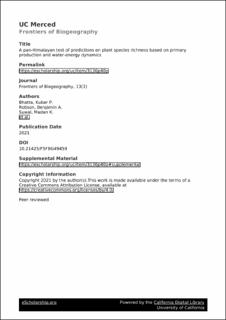| dc.contributor.author | Bhatta, Kuber Prasad | |
| dc.contributor.author | Robson, Benjamin Aubrey | |
| dc.contributor.author | Suwal, Madan Krishna | |
| dc.contributor.author | Vetaas, Ole Reidar | |
| dc.date.accessioned | 2022-04-05T09:08:43Z | |
| dc.date.available | 2022-04-05T09:08:43Z | |
| dc.date.created | 2021-06-02T10:17:44Z | |
| dc.date.issued | 2021 | |
| dc.identifier.issn | 1948-6596 | |
| dc.identifier.uri | https://hdl.handle.net/11250/2989851 | |
| dc.description.abstract | Spatial variation in plant species diversity is well-documented but an overarching first-principles theory for diversity variation is lacking. Chemical energy expressed as Net Primary Production (NPP) is related to a monotonic increase in species richness at a macroscale and supports one of the leading energy-productivity hypotheses, the More individuals Hypothesis. Alternatively, water-energy dynamics (WED) hypothesizes enhanced species richness when water is freely available and energy supply is optimal. This theoretical model emphasises the amount and duration of photosynthesis across the year and therefore we include the length of the growing season and its interaction with precipitation. This seasonal-WED model assumes that biotemperature and available water represent the photosynthetically active period for the plants and hence, is directly related to NPP, especially in temperate and alpine regions. This study aims to evaluate the above-mentioned theoretical models using interpolated elevational species richness of woody and herbaceous flowering plants of the entire Himalayan range based on data compiled from databases. Generalized linear models (GLM) and generalized linear mixed models (GLMM) were used to analyse species richness (elevational gamma diversity) in the six geopolitical sectors of the Himalaya. NPP, annual precipitation, potential evapotranspiration (derived by the Holdridge formula), and length of growing season were treated as the explanatory variables and the models were evaluated using the Akaike Information Criterion (AIC) and explained deviance. Both precipitation plus potential evapotranspiration (PET), and NPP explain plant species richness in the Himalaya. The seasonal-WED model explains the species richness trends of both plant life-forms in all sectors of the Himalayan range better than the NPP-model. Despite the linear precipitation term failing to precisely capture the amount of water available to plants, the seasonal-WED model, which is based on the thermodynamical transition between water phases, is reasonably good and can forecast peaks in species richness under different climate and primary production conditions. | en_US |
| dc.language.iso | eng | en_US |
| dc.rights | Navngivelse 4.0 Internasjonal | * |
| dc.rights.uri | http://creativecommons.org/licenses/by/4.0/deed.no | * |
| dc.title | A pan-Himalayan test of predictions on plant species richness based on primary production and water-energy dynamics | en_US |
| dc.type | Journal article | en_US |
| dc.type | Peer reviewed | en_US |
| dc.description.version | publishedVersion | en_US |
| dc.rights.holder | Copyright 2021 The Author(s) | en_US |
| dc.source.articlenumber | e49459 | en_US |
| cristin.ispublished | true | |
| cristin.fulltext | original | |
| cristin.qualitycode | 1 | |
| dc.identifier.doi | 10.21425/F5FBG49459 | |
| dc.identifier.cristin | 1913197 | |
| dc.source.journal | Frontiers of Biogeography | en_US |
| dc.identifier.citation | Frontiers of Biogeography. 2021, 13 (3), e49459. | en_US |
| dc.source.volume | 13 | en_US |
| dc.source.issue | 3 | en_US |

